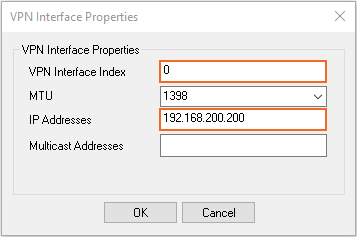VPN clients must authenticate themselves to the VPN server. A valid certificate is required for the client to verify the identity of the VPN server. To meet the security needs of your network, you can define username/password authentication and strict certificate requirements.
The Barracuda CloudGen Firewall supports multiple encryption algorithms for VPN connections. For TINA VPNs, multiple transport types are also available.
VPN Authentication Certificates
X.509 certificates are used by IPsec, L2TP/IPsec, and TINA (the Barracuda proprietary transport protocol). The certificates contain the following information:
- Public key.
- Some data signed by the private key for verification.
- Identity of the the CA.
- Identity of the owner.
- Key usage. Depending on what type of VPN and which clients you use, certain X.509 extensions might be required when creating the certificate.
For PPTP VPNs, external certificates are not needed because certificates are generated by the server at runtime.
Certificate CA (PKI)
Use an external CA (PKI) for firewalls that are standalone.
Depending on the certificate, you must export it in one of the following formats after it is created and signed:
| Certificate | File Format |
|---|---|
| Root Certificate | PEM or CER |
| Server Certificate | PKCS12, CER, or CRT |
| Service Certificate/Key | PEM |
| Client Certificate (if needed) | PEM |
Example Certificates for IPsec, L2TP, and iOS Clients
Supported Encryption Algorithms
The Barracuda CloudGen Firewall supports the following encryption algorithms for TINA, IPsec, and L2TP/IPsec VPN connections:
| Algorithm | Description |
|---|---|
| AES256 | Advanced Encryption Standard with 256-bit encryption. |
| AES | Advanced Encryption Standard with 128-bit encryption. AES is often chosen because it provides a good performance and security ratio. |
| 3DES | Triple DES. This algorithm is considered most secure but results in high system loads and lower VPN performance. |
| Blowfish | A keyed, symmetric block cipher developed to replace DES. |
| CAST | A 128-bit block cipher. |
| DES | Digital Encryption Standard. DES is the only export restricted algorithm available. |
| NULL | No encryption. |
TINA Transport Protocols
For TINA VPNs, the following transport types are available:
| Transport Protocol | Description |
|---|---|
| UDP | Stateless protocol that is best used for response-optimized tunnels. UDP is not recommended for unstable Internet connections. |
| TCP | Stateful protocol that is used if the tunnel runs over a proxy server. Higher protocol overhead limits the response time. TCP is preferred for unstable Internet connections. |
| UDP & TCP | Hybrid mode that creates two transport tunnels. To compensate for the weakness of both protocols, UDP is used for TCP connections, and TCP is used for stateless connections. |
| ESP | The tunnel uses ESP (IP protocol 50). ESP is best for performance-optimized tunnels, but it does not work if NAT routers must be traversed. |
IPv6 Support

The VPN service supports IPv6 for the VPN envelope. This means that the site-to-site and client-to-site VPN tunnels can be created between two IPv6 endpoints, but only IPv4 traffic can be sent through the tunnel. IPv6 is not supported for:
- Dynamic Mesh
- L2TP
- PPTP
- SSL VPN
VPN Routing Tables
You can configure how the VPN routes are introduced into the firewall's routing table.
- Separate Routing Table – By default, the CloudGen Firewall uses source-based routing and creates separate premain routing tables for every VPN tunnel.
- Single Routing Table – All VPN routes are inserted into the main routing table. VPN routes are inserted with a preference of 10.
Handling of Duplicate Routes
- When a duplicate route to an existing VPN route in the main routing table is announced to the CloudGen Firewall via RIP, OSPF, or BGP, a duplicate routing entry is created and the route that was added last is used.
- Creating a direct or gateway route with the same metric and destination as a VPN route in the main routing table results in duplicate routes. The route added last is used.
Enable the Single Routing Table for VPN Routes
- Go to CONFIGURATION > Configuration Tree > Box > Assigned Services > VPN-Service > VPN Settings.
- In the left menu, select General.
- Click Lock.
- Set Add VPN routes to main routing table to Yes.
- Click Send Changes and Activate.e
Enabling Local Out Traffic when using a Single Routing Table for VPN Routes
To send the local out traffic through the VPN tunnel, you must configure an IP address from the source network for the VPN interface.
- Go to CONFIGURATION > Configuration Tree > Box > Assigned Services > VPN-Service > VPN Settings.
- Click Lock.
- In the left menu, select Routed VPN.
- Next to the Interface Configuration table, click Add.
- In the VPN Interface Properties window, configure the following settings and then click OK.
- In the VPN Interface Index field, enter the number of the VPN interface. E.g.,
0for vpn0 - In the IP Addresses field, enter a box IP address that is also part of a published VPN network. E.g.,
192.168.200.200if one of the Local Networks of the VPN tunnel is 192.168.200.0/24.
- Click OK. The interface is now listed in the Interface Configuration table.

- In the VPN Interface Index field, enter the number of the VPN interface. E.g.,
- Click Send Changes and Activate.
Local Out traffic is now sent and received correctly through the Site-to-Site VPN tunnel.
